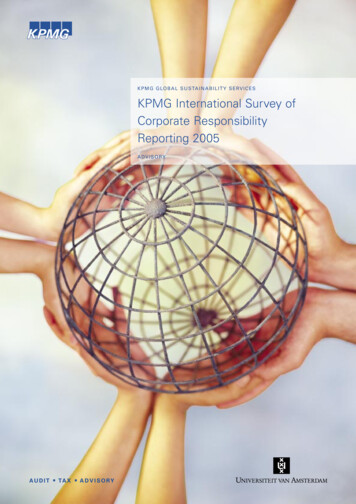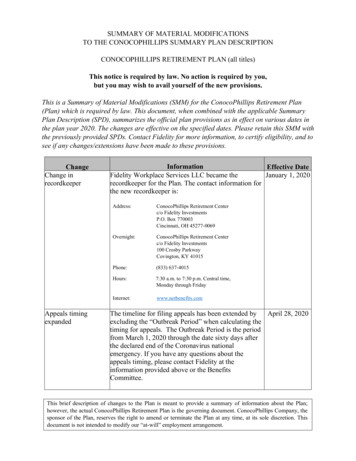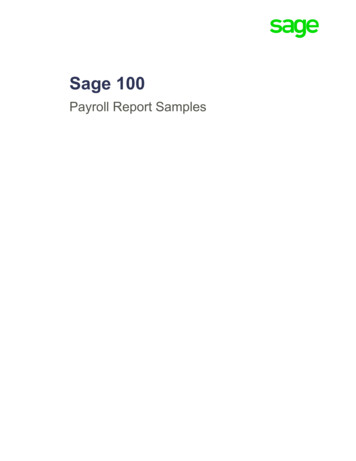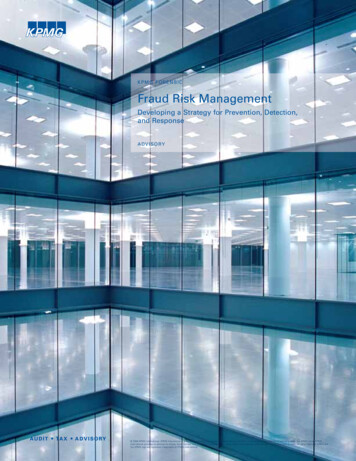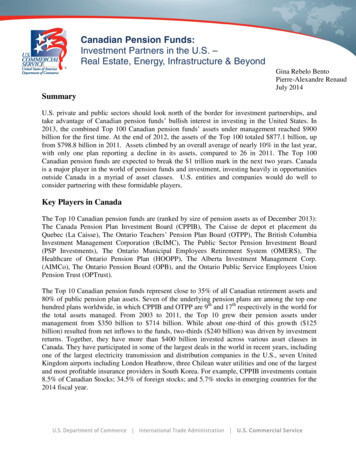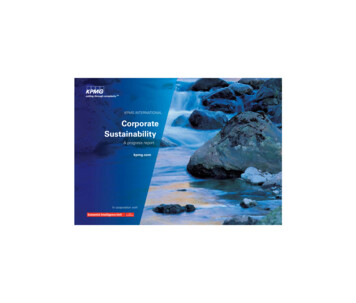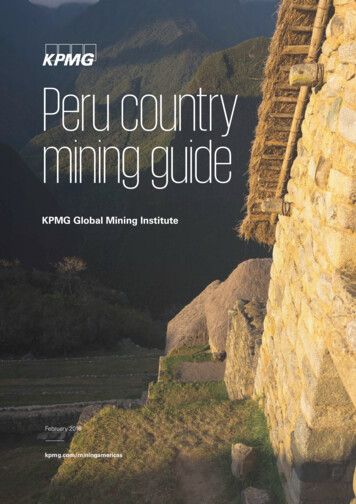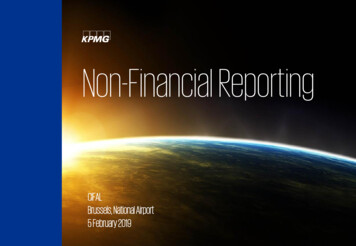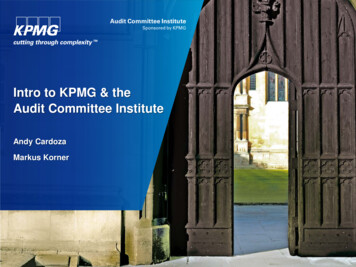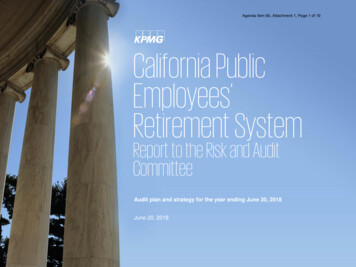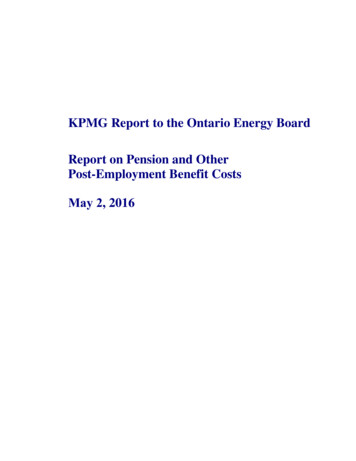
Transcription
KPMG Report to the Ontario Energy BoardReport on Pension and OtherPost-Employment Benefit CostsMay 2, 2016
ABCDKPMG LLPBay Adelaide Centre333 Bay Street, Suite 4600Toronto, ON M5L 1B2CanadaTelephoneFaxInternet(416) 777-8500(416) 777-8818www.kpmg.caMr. Theodore AntonopoulosManager, Electricity Rates and AccountingOntario Energy Board2300 Yonge StreetTorontoONM4P 1E4May 2, 2016Dear Mr. AntonopoulosRe: KPMG Report on Pension and Other Post-Employment Benefit CostsIn accordance with our engagement letter dated April 23, 2015 and Ontario Energy Board’sPurchase Order PO-001829 dated April 24, 2015, please find attached our report on Pension andOther Post-Employment Benefit Costs.It has been a pleasure working with the Ontario Energy Board on this engagement and we lookforward to presenting our report at the proposed Consultation.Yours trulyKPMG LLPMichel Picard, CPA, CAPartner(416) 777-8414KPMG LLP is a Canadian limited liability partnership and a member firm of the KPMG network of independentmember firms affiliated with KPMG International Cooperative (“KPMG International”), a Swiss entity.KPMG Canada provides services to KPMG LLP.
Table of ContentsPreface and Disclaimer . 1Acknowledgements . 4Executive Summary . 51.Introduction . 101.11.21.31.42.Methods Identified for Recovering Pension Costs and Information Requirements 162.12.2Overview of Section . 16Methods Identified for Recovering Pension Costs . 162.3Rationale for the Methods Identified for Recovering Pension Costs . 192.3.12.3.22.3.32.3.42.3.5Overview of Section . 19Summary: Pension Plans in Ontario and their Costing . 19Summary: Experiences and Practices in Other Jurisdictions. 23Rationale for Modified Funding Contribution Method vs. AccrualAccounting Cost Method . 25Previous Decisions by the OEB Regarding Pension Plans . 302.4Accounting Guidance for Pension Costs based on ASC 980 (US GAAP). 322.4.12.4.22.4.3General guidance applicable to both P&OPEB costs . 32Guidance for Pension Costs. 35Use of the ‘pay-as-you-go’ method or other methods of recovery forpension costs . 37Transitional regulatory liabilities upon switching from accrual accounting to‘pay-as-you-go’ . 37Actions that the OEB could take to influence the recognition of regulatoryassets for pension costs . 38Information Requirements Identified (with supplementary explanatorystatements) . 392.4.42.4.52.53.Purpose and scope of this report . 10Overview of P&OPEB Costs Incurred by Regulated Utilities in Ontario . 11Limitations of this Report . 13Report Outline . 14Methods Identified for Recovering OPEB Costs and Information Requirements. 53
3.13.23.33.3.13.3.23.3.33.3.43.3.6Overview of Section . 53Methods Identified for Recovering OPEB Costs. 53Rationale for the Methods Identified for Recovering OPEB Costs . 55Overview of Section . 55Summary: OPEB Plans in Ontario and their Costing . 56Summary: Experiences and Practices in Other Jurisdictions. 58Rationale for Accrual Accounting Costs Method vs. Pay-As-You-Go CashPayments Method .58Rationale for Adjusted Pay-As-You-Go Cash Payments Method vs. AccrualAccounting Costs Method . .60Previous Decisions by the OEB Regarding OPEB Plans . 623.4Alternatives for Possible Set-Aside Mechanisms . 633.4.13.4.23.4.3Background. 63Alternatives for Possible Set-Aside Mechanisms Identified . 65Transition to New Set-Aside Mechanism . 703.5Accounting Guidance for OPEB Costs based on ASC 980 (US GAAP) . 723.5.13.5.23.5.3General Guidance . 72Guidance for OPEB Costs . 72Illustrative impact of recovering P&OPEB costs on the ‘pay-as-you-go’basis . 77Transitional regulatory liabilities upon switching from accrual accounting to‘pay-as-you-go’ . 78Actions that the OEB could take to influence the recognition of regulatoryassets for OPEB costs . 79Information Requirements Identified (with supplementary explanatorystatements) . 803.3.53.5.43.5.53.6Appendix A – Types of P&OPEB Plans and Actuarial Valuation Methods . 92Appendix B – Cost Drivers for P&OPEB Costs and Plan Governance . 100Appendix C – Differing Accounting Frameworks for P&OPEB Plans . 103Appendix D – Trends . 114Appendix E – Industry Oversight . 120Appendix F – Experiences and Practices in Other Regulatory Jurisdictions . 124Appendix G – Simplified Example of Accounting for a Defined Benefit Plan . 136Page - ii
Appendix H – Recent Publicity Regarding the Funded Status of Pension Plans . 141Appendix I - Illustrative Examples of US GAAP Accounting Practices by CanadianRegulated Entities . 1431.11.21.3Accounting Practices for Pension – Regulatory Assets Recognized . 143Accounting Practices for OPEB – Regulatory Assets Recognized . 145Accounting Practices for OPEB – No Regulatory Assets Recognized . 147Appendix J - Examples of Additional Guidance issued under US GAAP by OtherRegulators . 1481.1Additional Guidance Issued by FERC. 148Appendix K – Specific Accounting Requirements under US GAAP. 1521.11.21.31.41.5General Accounting Requirements . 152Requirements for Regulatory Assets . 153Requirements for Regulatory Liabilities . 154Requirements for P&OPEB . 155Definition of terms used under US GAAP . 157Appendix L – Acronyms Used In This Report . 159Page - ii
ABCDReport on P&OPEB CostsMay 2, 2016Preface and DisclaimerBenefits provided to employees in consideration or exchange for service rendered to a utility takemany different forms (including salaries and wages, compensated absences, disability benefits,bonuses and incentive pay and post-employment benefits). Of these different forms of benefits,Pension and Other Post-Employment Benefit (“P&OPEB”) costs have been receiving muchattention in Canada, particularly in Ontario. Issues relating to P&OPEB costs are complicated bythe fact that the benefits are promised during the course of employment but the benefits are onlypayable after the completion of employment (i.e. post-employment benefits); often, this can beseveral decades after the date when service by an employee leads to benefits under the arrangement.This can have a profound impact on issues such as the nature of the benefits that are promised, whopays for and/or bears the risks associated with the benefits that have been promised, how the costof providing those benefits is allocated to each period in a rational and equitable manner, etc.This report does not seek to address all these issues. Rather, the Ontario Energy Board (“OEB”) isbeginning a consultation on rate-regulated utility P&OPEB costs in the electricity and natural gassectors (“the Consultation”). The objectives of the Consultation are to develop standard principlesto guide the OEB’s review of P&OPEB costs in the future, to establish specific informationrequirements for applications that may be incremental to current filing requirements, and todetermine whether appropriate regulatory mechanisms for recovery of P&OPEB costs can bedeveloped and applied consistently across the gas and electricity sectors for rate-regulated utilities.KPMG LLP (“KPMG” or “we”) has been retained by the OEB to provide assistance to the OEB onthe issues identified in this report. KPMG is not advocating positions in this report. Rather, we haveattempted to identify issues that we think are relevant to focus and inform the discussions that willtake place during the Consultation. We have also responded to and provided guidance and insighton specific technical accounting issues which are of interest to the OEB. However, in order to derivethe greatest value, users of this report should also acknowledge the following issues which areimportant to the discussion:1. KPMG understands that the OEB is not seeking to make drastic changes to the way it sets ratesas part of this review but rather to develop principles and requirements for P&OPEB costs basedon established rate-making principles such as intergenerational equity, rate stability andpredictability as well as statutory objectives such as financial viability of the electricity and gasindustry. There may be new regulatory filing and reporting requirements for P&OPEB costs. Itis also important to recognize that the OEB considers many factors in setting rates. Therefore,in some cases, implementation of new principles and requirements may have varying impact onthe existing practices of different utilities;2. The goal of achieving greater consistency should not over-ride the OEB’s statutory mandate toset ‘just and reasonable’ rates. In certain cases, a “one-size fits all” approach is simply not1
ABCDReport on P&OPEB CostsMay 2, 2016desirable or justifiable. For this reason, the principles and requirements should offer flexibilityin some areas;3. Benefits offered through P&OPEB plans are a form of deferred compensation and, often, thesebenefits are an integral part of the overall compensation that is provided to employees. As such,P&OPEB costs should not be viewed in isolation;4. This report identifies certain differences during a specified reporting period between theP&OPEB costs recorded under accrual accounting and their cash (or funding) cost. Thedifferences can be significant because the P&OPEB costs are defined by different frameworkswhich have specific and separate methodologies for setting assumptions and calculating costs.Indeed, there is no guarantee that one method will always result in higher (or lower) costs for agiven period than the other. Further, the accrual accounting cost method has differences thatrelate to different accounting requirements in the various accounting frameworks currentlyavailable for use in Canada. That said, despite these periodic differences in P&OPEB costs, inthe fullness of time, the cumulative cash (or funding) costs for a plan (or arrangement) isgenerally expected to equal that plan’s cumulative accrual accounting costs. This is trueregardless of the accounting framework that is used by a regulated utility. As such, over time, aregulated utility would recover all its P&OPEB costs irrespective of the method that is used toinclude these costs in rates. However, if the OEB were to move all the regulated utilities to acommon regulatory mechanism for including P&OPEB costs in rates, it will be important todetermine how, in the fullness of time, those regulated utilities that would have had to changetheir mechanism for recovering the costs are impacted in their ability to eventually recover theirprudently incurred costs through rates charged to customers;5. Due to the fact that revenue collected from customers to pay for P&OPEB costs may, in certaininstances, only be paid out by the regulated entity well into the future, an issue arises whethercustomers are getting an appropriate return or ‘value-for-money’ on the money that is held bythe regulated entity during the intervening period. The results of such ‘value-for-money’assessments would obviously depend on a number of factors, including how the regulated utilityhas used or invested the money that it would have collected in advance of the P&OPEBpayments. While KPMG has identified various options with ‘value-for-money’ in mind, theresults of any ‘value-for-money’ analyses would vary from utility to utility; as such, detailed,quantitative ‘value-for-money’ assessments are outside the scope of this report;6. The scope of the accounting guidance included in this report is limited, and is intended to onlyaddress the specific issues that have been identified by OEB staff. As such, the accountingguidance does not address all issues relating to P&OPEB costs neither is it intended to addressin detail all the accounting requirements under the various accounting frameworks. Such detailcan only be obtained from a complete read of all the accounting pronouncements andinterpretations issued by the relevant authoritative accounting bodies; and2
ABCDReport on P&OPEB CostsMay 2, 20167. We have prepared for consideration methods for recovering P&OPEB costs and relatedInformation Requirements that, if adopted, should lead to greater consistency in the regulatorytreatment of P&OPEB costs that are included in rates. KPMG is not responsible for determiningwhich, if any, of these methods for recovering P&OPEB costs and related InformationRequirements get adopted by the OEB. It is also possible to have variations to these methodsand Information Requirements or a different combination of individual methods andInformation Requirements.DisclaimerThis report has been prepared and is intended solely for the OEB and OEB staff. It is ourunderstanding that the OEB may conduct a public consultation on the issues that have been identifiedin this report; in which case, this report may be made available for ‘information only’ to theparticipants of that public consultation. The report may not be edited or relied upon by any otherperson without the express written permission by KPMG, which permission will not beunreasonably withheld.The accounting guidance contained in this report is general in nature and is not intended to apply toevery fact pattern. Like other issues relating to reporting in general purpose financial statements, itis possible to make different judgments based on specific facts and circumstances and materiality ofthe amounts involved.The accounting guidance contained in this report also does not deal with any specific fact pattern orrate proceeding that is currently before the OEB. However, the accounting guidance may inform andinfluence the OEB’s approach to P&OPEB costs in the future. The OEB (not KPMG) determineshow the issues identified in this report are dealt with for purposes of setting rates and relatedregulatory reporting. However, any and all decisions regarding how the issues identified in thisreport are addressed in a regulated entity’s general purpose financial statements are made by theregulated entity’s management, and auditors opine on those financial statements.Accounting pronouncements and interpretations are subject to revision by the relevant authoritativeaccounting bodies. The accounting guidance is based on our understanding of pronouncements andinterpretations at the date of this report. As such, the accounting guidance may change materially inresponse to subsequent changes or, revisions to, the pronouncements and/or interpretations. KPMGassumes no responsibility to update the accounting guidance.KPMG will not assume responsibility or liability for damages or losses suffered by anyone as aresult of circulation, publication, reproduction, or use of this report contrary to the provisions of thisdisclaimer. The information contained in this report is based solely on the purpose and scope ofwork set out herein, and is subject to the limitations set out in Section 1.3 of this report.3
ABCDReport on P&OPEB CostsMay 2, 2016AcknowledgementsKPMG wishes to acknowledge the assistance of others in the preparation of this report. In particular,the survey participants in Canada and internationally were most helpful in ensuring a fullunderstanding of their regulatory practices with regard to P&OPEB costs, and we thank them.KPMG benefitted particularly from the generosity of William McKenzie, Senior Manager TechnicalAccounting Regulatory Finance, Smarter Grids & Governance, of the Office of Gas and ElectricityMarkets (“Ofgem”), the regulator for Great Britain based in London, England. He responded toseveral follow up calls as the team evolved its understanding of the Ofgem framework and theparticulars of the regulatory regime in Great Britain.Staff of the Financial Services Commission of Ontario also assisted in providing understanding oftheir oversight role with regard to pension plans in Ontario and staff at OMERS, through OEB staff,provided insight into utility participation in the OMERS pension plan.Lastly, the staff of the Ontario Energy Board contributed to the development of this report,particularly with regards to the understanding of regulatory principles and the rate regulatory regimein Ontario. KPMG thanks them all for their assistance.This report reflects the results of significant collaboration and teamwork and KPMG gratefullyacknowledges the contributions of all participants.4
ABCDReport on P&OPEB CostsMay 2, 2016Executive SummaryThe OEB engaged KPMG to identify methods of recovering P&OPEB costs and develop associatedInformation Requirements for potential adoption by the OEB as a framework for addressing the rateregulatory treatment of P&OPEB costs for the electricity and gas utilities in Ontario and for usewhen reviewing rate applications.This report does not address specific criteria that can be used to assess the reasonableness ofP&OPEB costs in rate applications. The report outlines certain information requirements that maybe considered during the Consultation as a starting point for discussion on how to approach theassessment of P&OPEB costs. The bulk of the report focuses on alternatives for cost recoverymechanisms. This report also includes a jurisdictional review on the treatment of P&OPEB costs.A key finding of that review is that none of the regulators surveyed reported that their regulatorypractice for the treatment of P&OPEB costs is based solely on the application of the requirementsof accounting standards.Methods for Recovering P&OPEB Costs and Information RequirementsThis report summarizes KPMG’s work and identifies methods of recovering P&OPEB costs as wellas a set of Information Requirements for consideration by the OEB. The methods of recoveringpension costs and related Information Requirements are set out in Section 2 of this report. Methodsof recovering OPEB costs and related Information Requirements are set out in Section 3 of thisreport.There are two primary methods that have been used by regulated utilities in Ontario to recoverP&OPEB costs in the rates charged to customers – legislated funding contribution (for registeredpension plans only) and/or accrual accounting costs (for registered and unregistered pension plansand OPEB plans). A third method, ‘pay-as-you-go’ cash payments, is currently only used by a fewregulated utilities in Ontario.We have identified an additional method for pensions that is an alternative to the above-mentionedlegislated funding contribution method, i.e. the “Modified Funding Contribution method”. TheModified Funding Contribution amount represents the minimum amount of contributions requiredto be made by a sponsor of a registered pension plan that is subject to the requirements of pensionlegislation under the Pension Benefits Act, Ontario (“PBA”), modified by the fact that only anemployer’s normal cost contribution and going concern special payments using the 15-yearamortization period are included in the current period’s rates. Any other special payments requiredunder the PBA and other additional payments beyond the minimum funding contributions requiredby the PBA that an employer chooses to make would be recorded in separate deferral accounts, andbe recovered in the rates in a future period as determined by the OEB. The overall result is that theamount calculated under the Modified Funding Contribution method would be less volatile than theamount calculated using the (traditional) funding contribution method that is described above.5
ABCDReport on P&OPEB CostsMay 2, 2016For OPEB costs, we have also identified an additional method that is an alternative to the, ‘pay-asyou-go’ cash payments method, i.e. the adjusted ‘pay-as-you-go’ cash payments method. Under thismethod, ‘pay-as-you-go’ cash payments are the starting point (foundation) for determining theamount that is included in rates. However, such ‘pay-as-you-go’ cash payments are increased by anadditional amount that is established by the OEB.We have also identified Information Requirements that would support the regulatory review ofP&OPEB costs. In some instances, the Information Requirements represent codification of existingrequirements that have not been previously codified as part of the OEB’s regulatory requirements.However, in other instances, the Information Requirements do result in new regulatory filing andreporting requirements. The impact may be significant; details of the extent of the changes andimpact of those changes can only be determined on a case by case basis.The proposed public consultation may wish to consider the methods for recovering P&OPEB coststhat have been identified in this report as well as some, or all, of the accompanying InformationRequirements. If the OEB were to adopt the methods for recovering P&OPEB costs and theInformation Requirements identified in this report, this would have the following impact onregulated entities: Pension plans accounted for as DC plans: No change to existing regulatory treatments. Thisincludes costs with respect to multi-employer pension plans such as OMERS which are definedbenefit plans but are accounted for by participating employers as DC plans. Registered pension plans accounted for as DB plans: The OEB may wish to considerchanging the method of recovering these costs to the Modified Funding Contribution method.Any special payments or other additional payments not included in that period’s rates (i.e.“excess payment”) would be included in deferral accounts pending the OEB’s decision ondisposition of the amount and would attract an appropriate return.There are a number of reasons that suggest using the funding contribution rules as opposed tothe accounting rules: transparency and greater objectivity in setting assumptions, the fact that itis easier for stakeholders to understand the inclusion in rates of ‘cash costs’ and, as the amountsincluded in rates do not depend on the accounting framework that is adopted by a utility, greaterconsistency and comparability between regulated entities and thus more equitable treatment ofcustomers, and the avoidance of excess/(under) recovery of cash which can occur when accrualaccounting costs are included in rates. By modifying the amount that is included in the currentperiod’s rates to comprise only an employer’s normal cost contribution and going concernspecial payments using the 15-year amortization period, this would significantly reduce thevolatility of amounts determined using the funding contribution rules of the PBA. On the otherhand, the OEB would retain flexibility regarding the timing and period of recovery of anyamounts that are paid by a utility in excess of the Modified Funding Contributions. [Adoptingthis method for recovering pension costs will result in change for some large electricity andgas utilities in Ontario that previously used the accrual accounting cost for DB plans in settingrates]6
ABCDReport on P&OPEB CostsMay 2, 2016Non-registered P&OPEB plans: No change to existing regulatory treatment for non-registeredpension plans and OPEB plans if the accrual accounting cost method is adopted. However, ifthe accounting framework that is used by a utility does not periodically reclassify to net incomethe component of P&OPEB costs that is recorded in OCI, a utility would be required to recordthat amount in a deferral account that is amortized and included in rates based on the expectedaverage remaining service life of the members of the plan. Further, if cost recoveries are basedon accrual accounting cost, the considerations for a set-aside mechanism that is discussed furtherbelow would be relevant to any P&OPEB costs that are recovered using this method.On the other hand, if the adjusted ‘pay-as-you-go’ cash payments method is adopted for nonregistered P&OPEB plans, this would represent a significant change for most regulated utilities.[Adopting these methods for recovering P&OPEB costs for non-registered plans will resultin significant change for the industry] All P&OPEB plans: The identified Information Requirements introduce increased regulatoryfiling requirements for P&OPEB costs in rate applications and additional reporting requirementsfor ongoing monitoring by the OEB.Details of the extent of the impact of the changes vary from utility-to-utility and can only bedetermined on a case-by-case basis.Accounting guidance for P&OPEB costs based on ASC 980 (US GAAP)US GAAP includes special accounting provisions that are applicable to entities with activities thatare subject to rate regulation. The result is that regulated entities are required to recognize regulatoryassets and liabilities provided certain specified criteria are met. This analysis was conducted in orderto assess the impact of deferring costs for rate-making purposes (under the methods discussed in thisreport) on utilities currently under US GAAP. This analysis is also informative for utilities thatelected to apply the regulatory accounting guidance that was recently introduced under IFRS asIFRS looks to the US GAAP standard for guidance on this matter1.In order to capitalize an incurred cost (including amounts recognized in Other ComprehensiveIncome) as a regulatory asset, a regulated entity is required to assess whether it is probable thatfuture revenue in an amount at least equal to the capitalized cost will result from inclusion of thatcost in allowable costs for rate-making purposes. Determining whether it is probable that incurredcosts will eventually be included in rates is often the most difficult part of applying the accountingrequirements for regulatory assets. Actions by the regulator can greatly influence the recognition ofregulatory assets.The level of judgment involved is much more significant for P&OPEB costs as the period ofrecovering these costs from customers can extend well into the future. As such, subject to it being1Refer to Section 2.4 of this report for details.7
ABCDReport on P&OPEB CostsMay 2, 2016probable that the costs will be included in future rates, US GAAP has the following specificrequirements for P&OPEB costs:a) Pension costs: as detailed in Section 2.4.2 of this report, regulatory assets and liabilities aregenerally recognized. US GAAP does not specify any time limits for the recovery of the pensioncosts in future rates; andb) OPEB costs: US GAAP explicitly prohibits the recognition of regulatory assets when OPEBcosts are recovered on a ‘pay-as-you-go’ basis. For those OPEB costs that are not recovered inrates on a ‘pay-as-you-go’ basis, and subject to certain specified criteria being met (see detailsin Section 3.5.2 of this report), regulatory assets and liabilities are generally recognized. Assuch, regulatory assets may be recognized for OPEB costs as long as the method of recovery isnot ‘pay-as-you-go’ and the other specified criteria are met. There is no requirement under USGAAP for OPE
KPMG LLP Bay Adelaide Centre 333 Bay Street, Suite 4600 Toronto, ON M5L 1B2 Canada Telephone (416) 777 -8500 Fax (416) 777-8818 Internet www.kpmg.ca KPMG LLP is a Canadian limited liability partnership and a member firm of the KPMG network of independent
